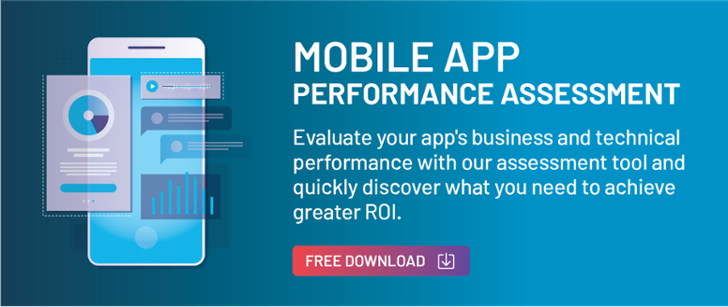In a previous article, we highlighted 12 mobile KPIs you need to be tracking to see more ROI. But, how do you go about gathering data for those KPIs? And once you’ve gathered that information, what do you do with it? This article will take a deeper dive into the world of mobile app analytics, why they are essential, and go over some best practices for collecting this information.
What are mobile app analytics?
Mobile app analytics is the term used to describe the accumulation and analysis of data gathered from the activity that occurs on your mobile app. Once you’ve collected that data, the goal is to turn that data into information and insight. The insight you get from your mobile app analytics will enable you to better understand how your users engage with your app, how well your app performs, and identify common problems with the app’s user experience. As a result, you’ll be in a better position to make informed decisions on app improvements that will optimize engagement, app churn, conversions, and downloads.
Why is mobile app analytics important?
Once you’ve launched your app into the market, it’s essential to identify what you can optimize to ensure product growth, improved performance, and customer satisfaction. After all, mobile app development is an iterative process that requires continuous optimization. Without mobile app analytics, you won’t identify the best areas to allocate your resources and push towards your goals. For example, mobile app analytics can specify the number of times your app crashes. If this number is significant, it can be a reason why you have a high churn rate, indicating you will need to allocate funds and resources to improve your backend.
Five mobile app analytics best practices
Define the user journey
A user journey builds a holistic view of a customer’s entire experience with a mobile product by defining moments of irritation and delight through a series of interactions and highlights the process a person follows to accomplish a particular goal. It’s essential you define the steps in this journey to track the right events to identify where users churn. Having your user journey mapped out is the first step towards optimizing your user funnel and ensuring your users will convert.
Measure what matters
With so many metrics to track, it’s essential you take the time to identify which KPIs matter most to you and your business objectives. Without focusing on the metrics that affect you most, you run the risk of wasting resources on less impactful optimizations. Once you have identified your business objectives and know the steps in your user journey, you can use it to understand which metrics will provide critical insights.
Use industry benchmarks to inform your targets.
Industry benchmarks are a useful way to gauge how your app is performing. Because user behaviors vary based on app functionality, using industry benchmarks to inform your goals will enable you to see how your stack up to competitors more accurately.
Make use of mobile app analytics tools.
When it comes to understanding why users may be leaving your app, it’s important to track more than installs and uninstalls. While gathering all of the critical metrics you need to follow sounds daunting, using the right mobile app analytics tool can make things a lot simpler. Ultimately, these tools can help streamline your reporting so you can focus your efforts on how to excel your app and less on inputting data into a chart.
Invest in qualitative data
When it comes to app analytics, it’s a good idea to gather more than just quantitative data. While this type of data is essential, it doesn’t present you with the full picture. We recommend collecting qualitative data as well. Talk to users, send in-app messages to get their feedback, run focus groups, send out surveys and questionnaires. In tandem with the quantitative data you collect, this type of data will help provide a much clearer picture of how users are engaging with your app.
Final Takeaways
Mobile app analytics are an essential part of mobile app development and shouldn’t be thrown to the wayside. By following the best practices outlined above and tracking these 12 mobile KPIs, you’re setting yourself up for the best chance at success. As mentioned earlier, mobile app development is an iterative process, and if you aren’t aware of how your users are using your app, how will you know what needs to be optimized?



